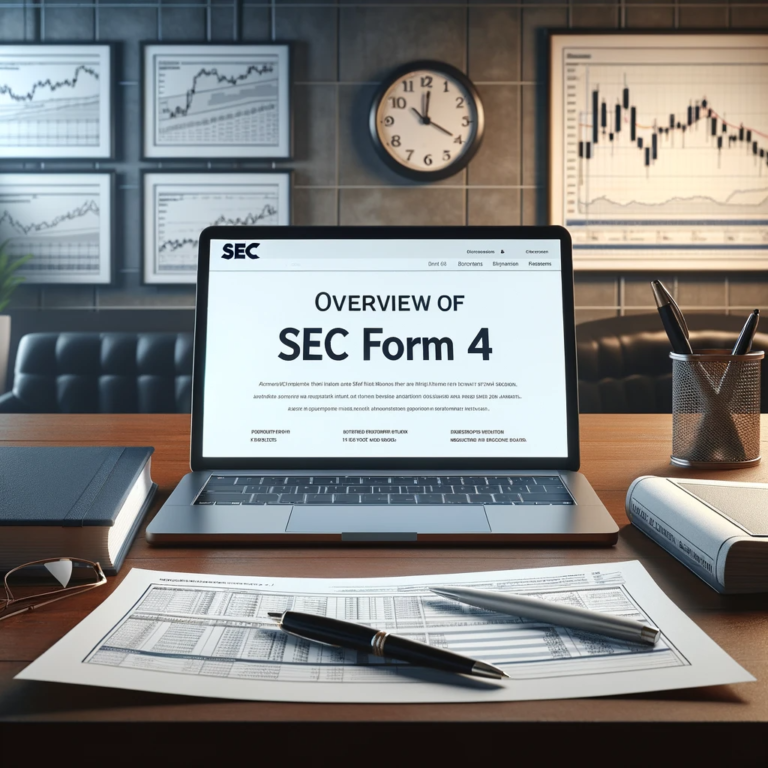SEC Form 4 – A Comprehensive Guide for Investors

What is SEC Form 4?
SEC Form 4 – SEC Form 4 is a mandatory regulatory filing that must be submitted to the Securities and Exchange Commission (SEC) any time an insider of a public company executes a transaction in the company’s securities. Insiders are defined as officers, directors, and any shareholders owning 10% or more of the company’s stock.
Specifically, Form 4 discloses purchases, sales, and other changes in ownership of a company’s securities by insiders. It provides detailed information on the nature of each transaction, including the number of shares traded and the price. This transparency enables public investors to monitor what insiders are doing with their holdings.
Form 4 filings help detect potential cases of illegal insider trading based on material non-public information. They also provide insights into management and large shareholders’ confidence in the company. Analyzing Form 4 trends and patterns can inform investment decisions.
The SEC enacted Form 4 under Section 16(a) of the Securities Exchange Act of 1934. The rules have evolved over decades but the essential transparency objective remains unchanged. Form 4 is one of the most important and closely scrutinized regulatory filings.

Why is SEC Form 4 Important?
SEC Form 4 serves several vital purposes:
- Prevents illegal insider trading – The transparency of trades deters insiders from improperly acting on confidential information.
- Promotes good governance – Requiring prompt disclosure aligns insiders’ interests with public shareholders.
- Provides information to investors – Trading patterns offer insights into management sentiment and potential changes.
- Increases public confidence – Openly disclosing insider transactions reassures retail investors.
- Supports fair, efficient markets – The information helps keep stock prices at appropriate levels.
- Enables regulatory oversight – The SEC uses Form 4 to monitor and enforce securities laws.
Form 4 is important because it ensures insiders cannot secretly execute transactions based on information that the public doesn’t have. This levels the playing field for ordinary investors.
How to Read a SEC Form 4
SEC Form 4 filings follow a standard template and structure. Learning how to interpret the various sections provides useful context on insiders’ transactions.
Identifying the Reporting Person and the Issuer
The reporting person is the insider executing the transaction. Form 4 shows their name, the company, and their relationship such as CEO, Director, or 10% owner.
The issuer is the public company whose securities are being transacted. The company’s name, CIK code, IRS number, address, and ticker symbol identify the issuer.
Understanding the Nature of the Transaction
This section discloses the type of transaction using standardized codes. Common transaction types include open market purchases (P), sales (S), option exercises (X), and stock awards (A).
Form 4 may cover multiple transactions across different securities. Footnotes explain complex transaction types.
Determining the Number of Securities Transacted
Form 4 shows the specific number of shares (or dollar value for debt instruments) traded in the transaction. This quantity reflects the change in the reporting person’s holdings.
For indirect ownership through a trust or other entity, the form adjusts the number to reflect the insider’s beneficial ownership rather than the total entities’ shares traded.
Checking the Transaction Price
The price per share or unit price for debt securities is disclosed. This allows investors to evaluate whether the insider paid or received fair market value.
For market trades, the price is straightforward. Indirect transactions like option exercises or conversions involve more complex valuation.
Assessing Post-Transaction Ownership
Form 4 summarizes the reporting person’s updated number of shares owned after the transaction. This helps track accumulations and dispositions over time.
Ownership numbers are presented both directly and indirectly as beneficial owner. The totals encompass all classes of stock held.
Understanding Derivative Securities
Transactions often involve derivative securities like employee stock options rather than simply common shares. Sections cover the expiration date, strike price, and updated holdings of any derivatives.
For example, an insider may exercise 5,000 options with a $10 strike price to acquire 5,000 shares of common stock. The form would disclose the exercise and resulting increase in underlying share ownership.
Reading the Footnotes
Footnotes provide additional explanatory details for more complex transactions. This includes indirect ownership through a trust or minor children. The footnotes spell out the reporting person’s relationship to provide clarity.
Form 4 requires attaching any relevant agreements and contracts describing unusual transactions that occurred. The footnotes indicate if any optional exhibits are included.
What are SEC Form 4 Transaction Codes?
SEC Form 4 features coded descriptions for each transaction. Learning these codes helps quickly identify the nature of insiders’ transactions.
Common Transaction Codes
Here are some of the most frequent transaction codes:
- P – Open market purchase of common or preferred shares
- S – Open market sale of common or preferred shares
- M – Exercise of stock options for cash (cashless exercise done under code F)
- A – Grant or award of stock from the company
- D – Sale on the open market to cover option exercise price or taxes
- F – Cashless exercise of stock options
- J – Sale of shares to cover option exercise costs or taxes
- X – Exercise of in-the-money stock options
- V – Grant or award of employee stock options contract
Deciphering Transaction Codes
Researching the full list of transaction codes provides helpful context. For example, code I covers sales done under SEC Rule 144 during restrictions after an affiliate leaves the company. Code K shows acquisition of shares through inheritance.
Focus on the big picture trends and volume of routine open market and stock option transactions. But check the footnotes to understand special situation codes.
How to Track Form 4 Filings?
All Form 4 filings by public companies can be tracked through the SEC’s EDGAR database available on sec.gov. Filings can be searched by company name, individual insider name, or CIK code.
Many financial websites also compile Form 4 data in user-friendly formats. This allows scanning for notable insider transactions or analyzing trading patterns over time. Set up alerts for key insiders’ Form 4 activity.
While filed publicly, Form 4 disclosures are not publicized until days or weeks later when posted. Use EDGAR filings rather than press reports for timely tracking.
What is the Difference Between Form 3, Form 4, and Form 5?
Form 3, 4, and 5 are insider reporting requirements under Section 16 of the Securities Exchange Act. Here are the key differences:
- Form 3 – Initial statement of ownership of covered securities
- Form 4 – Report of changes of ownership within 2 business days
- Form 5 – Annual statement of beneficial ownership
Think of them as:
- Form 3: Opening snapshot
- Form 4: Ongoing progress reports
- Form 5: Year-end summary
Form 3 shows an insider’s holdings when assuming the role or passing 10% ownership. Form 4 discloses transactions as they occur. Form 5 wraps up changes not previously reported.
Are SEC Form 4 Filings Good or Bad?
There is no definitive good or bad interpretation of Form 4 filings. Context matters greatly when assessing insider transactions.
Contextualizing Insider Transactions
- Routine small trades may not be meaningful vs large transactions based on new information.
- Personal circumstances like estate planning or divorce can motivate sales unrelated to company views.
- Exercises of expiring options or tax sales do not necessarily signal a negative outlook.
- Pre-scheduled 10b5-1 trading plans initiate sales automatically, not based on sentiment.
Analyzing Form 4 Trends
- Patterns over time and across insiders provide better insight than isolated transactions.
- Increased buying across executives may reflect a positive outlook.
- Sales surging before bad news can indicate issues not yet public.
- Deviations from usual trading patterns tend to be more significant.
There is no foolproof formula for interpreting Form 4s. Take time to understand motivations behind transactions rather than jumping to conclusions.
How to File a Form 4?
Insiders are responsible for ensuring timely and accurate Form 4 filing when executing covered transactions. Here are tips for proper filing:
Navigating EDGAR Filing
Form 4 must be filed electronically through the SEC’s EDGAR system available at sec.gov. EDGAR filing requires formatting documents based on the system’s technical specifications.
Most public company insiders rely on counsel and compliance teams to handle EDGAR filing rather than doing so themselves. This ensures proper formatting and guarantees timely submission.
Meeting Filing Deadlines
The tight Form 4 deadline requires filing within 2 business days of the transaction date. There is no flexibility for late filing barring exceptional circumstances.
EDGAR accepts filings 24 hours a day to allow filing outside of business hours if needed before the deadline. Confirmation emails validate successful Form 4 submission.
Are There Any Penalties for Not Filing Form 4?
Failing to properly file Form 4 is a violation that carries civil penalties and risks other SEC enforcement action.
- Monetary penalties up to $100,000 for individuals per violation.
- Cease and desist orders, bars from serving as an officer or director, and trading suspensions.
- Sarbanes-Oxley Act increased penalties to further compel compliance.
In addition, the SEC may force disgorgement of any profits from transactions that violated securities laws. Criminal charges are possible for willful violations.
Insiders should take Form 4 obligations seriously given the steep penalties. However, most late filings result in lighter non-public warnings rather than formal prosecution. Still, violations can damage reputations and careers even if fines are not imposed.
How do you research SEC filings?
Here are helpful tips for researching SEC filings like Form 4:
Using EDGAR for SEC Filings Search
- EDGAR at sec.gov contains the full universe of SEC filings available for download.
- Use company name, individual name, or CIK code searches to find Form 4.
- Filter or scroll through filing types. Form 4 is under “4 Statement of changes in beneficial ownership of securities.”
- View in html, text, or Excel CSV format. CSV allows data analysis.
- Sign up for email alerts on new filings matching your search criteria.
Additional Resources for SEC Research
- Many stock analysis sites offer helpful SEC data compilations, graphs, and screening tools.
- Real time Form 4 tracking dashboards from sites like InsiderInsights and Form4Oracle.
- Research services like S&P Global and FactSet compile filings.
- Useful to compare multiple sources to avoid missing any filings.
Leverage both the raw EDGAR filings and third-party compilations to speed research and gain insights.
Can I Use EDGAR for SEC Form 4 Filings Search?
Yes, EDGAR is the primary resource for searching and retrieving SEC Form 4 filings.
EDGAR Form 4 Search Tips
On EDGAR, navigate to “Search for Company Filings” and select form type “4” to find SEC Form 4s.
- Quick Search works well searching by company name or part of the name. Can filter by filing date range.
- Advanced Search allows more filters like person name, form type, period, word in filing content.
- CIK Lookup finds the unique CIK code for a company to search filings.
- Use date filters to find latest Form 4s or track patterns over time.
EDGAR provides bulk downloads if analyzing many Form 4s across companies and insiders. Overall, EDGAR provides user-friendly access to all historical and current Form 4 filings.
Key Takeaways
- Form 4 is an SEC requirement for insiders to promptly report transactions in company shares. This provides transparency around potential insider trading.
- Understanding how to read the detailed information on Form 4 provides insights into management sentiment.
- Monitoring Form 4 filing trends over time can inform investment decisions, but proper context is crucial.
- EDGAR serves as the primary repository for researching actual Form 4 filings by company insiders.
Form 4 is a valuable source of information for investors seeking an informational edge when evaluating companies and their leadership teams.






